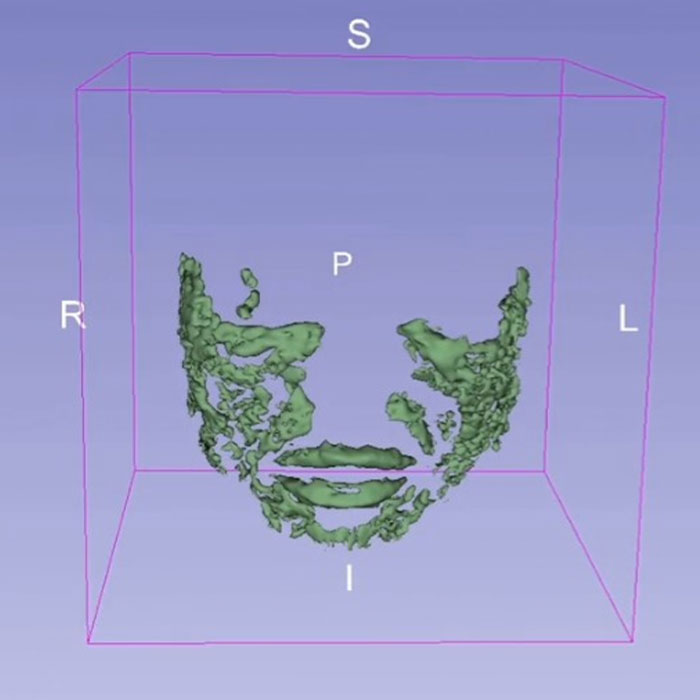In the pursuit of youthful, radiant skin, many people turn to injectable fillers as a quick and convenient solution. Hyaluronic acid-based fillers, in particular, have become a popular choice, promising to smooth wrinkles, restore volume, and enhance facial features. However, a recent viral video featuring an MRI scan has shed light on a concerning reality about these seemingly harmless injectables.
Oculoplastic surgeon Dr. Kami Parsa, based in Beverly Hills, California, has captured the attention of thousands with his TikTok video showcasing the MRI of a 33-year-old patient who had received over 12 CC of hyaluronic acid fillers over the past six years.
The MRI footage revealed a surprising discovery: the patient’s face was illuminated with green dots, indicating that the filler had not only remained in the patient’s face but had actually grown and migrated to other areas, totaling a staggering 28 CC – more than twice the amount originally injected.

Dr. Parsa explained that this phenomenon is due to the hydrophilic (water-loving) nature of hyaluronic acid fillers. These fillers not only retain water but also stimulate tissue growth, leading to the observed expansion and migration of the injectable material over time. This revelation has raised concerns among viewers, who have questioned the long-term effects of such substantial filler accumulation on the lymphatic system and overall facial structure.
While hyaluronic acid fillers are often touted as a temporary solution, with an expected lifespan of 6 to 18 months, the MRI footage suggests that the reality may be quite different. The patient in question had received injections over several years, and the resulting accumulation and migration of the filler material challenge the notion of a short-lived enhancement.
As the popularity of injectable fillers continues to soar, it is crucial for individuals to understand the potential risks and long-term implications of these procedures. Patients should have open and honest discussions with their healthcare providers, inquiring about the longevity of the fillers, potential side effects, and the overall safety and efficacy of the treatments.

Healthcare professionals, particularly those performing injectable treatments, have a responsibility to educate their patients and provide transparent information about the potential risks and limitations of fillers. By promoting a more informed and cautious approach, practitioners can help their patients make well-informed decisions and potentially avoid the unintended consequences of excessive or inappropriate filler use.
In the world of beauty and aesthetics, few topics have sparked as much controversy and confusion as hyaluronic acid fillers. From celebrities facing backlash for their “overfilled” appearances to everyday people struggling to understand the truth about the longevity of their treatments, this injectable has become a hot-button issue. As a seasoned SEO expert and high-end copywriter, I’m here to shed light on the unbelievable truths about hyaluronic acid fillers that you won’t find anywhere else.
One of the most persistent myths surrounding hyaluronic acid fillers is that they only last for 6 months. However, as we’ve seen from the comments in the introduction, this couldn’t be further from the truth. Patients have reported their fillers lasting for years, with one individual claiming their chin filler has remained unchanged for a decade. So, what’s really going on here?

The longevity of hyaluronic acid fillers can vary greatly depending on a number of factors, including the individual’s metabolism, the placement of the filler, and the quality of the product used. While some fillers may indeed only last for 6 months, high-quality, properly placed fillers can often persist for years, much to the surprise of both patients and their providers.
As the use of facial fillers has become more prevalent, we’ve seen a concerning trend of patients and providers alike taking things too far. Overdosing on Botox can lead to severe muscle weakness and an artificial, “frozen” appearance, while overfilling with hyaluronic acid can result in the dreaded “pillow face” look. It’s a fine line to walk, and the consequences of poor judgment can be significant.
One of the key factors in achieving natural-looking, long-lasting results with hyaluronic acid fillers is selecting a skilled, experienced provider. Inexperienced injectors may use too much product or place it in the wrong areas, leading to undesirable outcomes. It’s crucial to do your research and find a qualified professional who can create a customized treatment plan that enhances your natural features without going overboard.

Even after finding the perfect provider and achieving your desired look, keeping your hyaluronic acid fillers looking their best requires ongoing maintenance. This may involve touch-ups, supplementary treatments like Sculptra for collagen stimulation, and a comprehensive skincare routine to support the health of your skin.
The world of hyaluronic acid fillers is a complex and often misunderstood one, but with the right information and guidance, you can navigate it with confidence. By debunking the myths, understanding the realities of filler longevity, and learning how to avoid the pitfalls of overdoing it, you can achieve the natural, youthful look you’ve been longing for. Remember, when it comes to injectables, knowledge is power – and with this article, you’re one step closer to becoming a filler pro.


